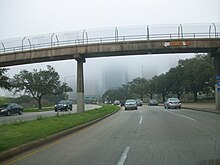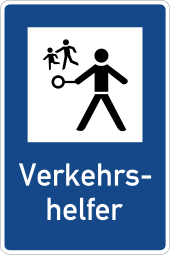Pedestrian safety
Under pedestrian safety is defined as the totality of measures and devices in traffic life, for optimal secure the pedestrian as road users are aligned.
The hazard
Walking and pedestrian traffic are the natural forms of human locomotion. According to CARE, pedestrian accidents are the second most common cause of death in European road traffic with a share of 20 percent. They account for a third of fatal accidents in urban traffic.
The extensive road traffic and the high dynamics and speed of the vehicles create a high potential risk that not all pedestrians can cope with. Another problem is the dense traffic at certain times of the day, including the so-called school rush hour .
Children, the elderly and the infirm are exposed to a particularly high risk in today's traffic life. Nevertheless, according to today's traffic education there is no longer any reason for fatalism , as Peter-Habermann accusingly expressed in 1979 with the phrase “children have to have an accident”. The countermeasures taken now take international account of the fact that pedestrians, the weakest group of road users, are particularly in need of protection.
Urban planning measures
As early as 1935, a division of the traffic area between pedestrians and vehicles was carried out, which was already connected with rules of conduct for pedestrians. (§ 37 RStVO, RGBl. 1937 I, p. 1188, cf. today § 25 StVO ): For example, § 25 Paragraph 1 of the Road Traffic Regulations (StVO) regulates: “ Pedestrians must use the sidewalks. They are only allowed to walk on the carriageway if the street has neither a sidewalk nor a hard shoulder . ”In 1937 the first pedestrian traffic lights were set up in Berlin.
Urban planners contribute to improving pedestrian safety in road traffic by decelerating motor traffic through structural measures and speed limits and providing protection areas. They create spaces in traffic in which pedestrians can move relatively safely. Possible measures include pedestrian areas , walkways , pedestrian bridges , pedestrian tunnels , pedestrian crossings , pedestrian crossings , traffic islands , pedestrian lights , pedestrian signs , traffic-calmed areas or play streets .
In Augsburg and Cologne z. For example, test systems of so-called Bompeln , which pedestrians ( smombies ) who are distracted by the operation of their smartphones, are to draw attention to the dangers of cross traffic by means of LED lamps embedded in the floor - if necessary flashing red.
Vehicle technology measures
In recent years, the automotive industry has made decisive progress in pedestrian protection in the form of design improvements to vehicles that are intended to minimize the severity of accidents in the event of a collision with pedestrians. These include, for example, the ban on front protection bars , the so-called "cow catchers", the establishment of crumple zones that dampen the impact energy, and the development of highly effective braking systems.
The Euro NCAP (European New Car Assessment Program - European New Car Assessment Program ), based in Brussels leads since 1996 regularly crash tests with new car models by where also the pedestrian protection arrives in the points classification.
Policy measures
With the KMK recommendation of July 7, 1972 , "traffic instruction" came to schools and universities for the first time as a comprehensive, compulsory educational mandate, and thus also in the field of view of a broader public. Traffic education was anchored in the curriculum in all federal states. Training guidelines were drawn up that made parents and educators responsible. The drivers were made aware of their potential risk through regular campaigns. Facilities such as traffic officers , traffic assistants , school guides , school route helpers were specially geared towards the previously neglected pedestrian safety.
The Federal Government repeatedly initiates road safety programs and campaigns aimed at a fundamental reduction in the number of accidents. The Scientific Advisory Board at the BMVBS drafts recommendations for future planning.
Measures of pedagogy
The structural measures provided by the modes of transport to mitigate dangers, the design contributions of the vehicle manufacturers or the considerate behavior of other road users are helpful. Decisive for the road safety of the pedestrian are, however, the own traffic competence and the willingness to take responsibility and self-assurance:
Protective traffic crossings and traffic aids are useless if they are not used, and mistakes by other road users can only be effectively countered by self-protective behavior in the sense of accident avoidance. This insight is spread through the sarcastic headstone saying : "But he had priority on the zebra crossing". The pedestrian cannot and must not rely on the faultlessness and compliance with the rules of the other road users.
According to the objectives of traffic education, every child should be able to organize their way to school independently and responsibly when they start school or after the first few weeks of instruction. In order to develop this own traffic competence, according to SA Warwitz, he has to develop “traffic feeling”, “ traffic sense ”, “traffic intelligence” and the resulting “traffic behavior”. The classic ways to do this are taught by traffic education. As the first instance, the legislature has assigned the parents the proper introduction to traffic life as an obligatory task within the framework of the parental duties of upbringing . The professional traffic education of kindergartens and schools should build on them.
Professional traffic education is geared towards the safe, independent, responsible and partnership-based participation of pedestrians in road traffic, where any pointing finger mentality is frowned upon towards other road users. Modern pedestrian education is no longer limited to traffic education for children and adolescents: As school guides, school walkers, school bus attendants, tutors and examiners, not only older schoolchildren, but also interns, student teachers, parents and other adults interested in training programs such as the pedestrian diploma and Projects such as the school way game are integrated and benefit indirectly from the learning processes on the way to more pedestrian safety.
Initiatives such as the Pedibus , the children accompanied a Fußgang to kindergarten or school permits, but also the organization of the crossing guards service will materially from volunteer supported operating dedicated adults.
Issues detrimental to security
In traffic education, the following behaviors and facts are named as counterproductive for road safety, especially for young pedestrians:
- Missing, failed or inconsistent traffic education
Although practicing how to deal with traffic is a legally required part of parental responsibility, many parents assign this task to public institutions such as kindergartens, the police and schools. They do not trust the effectiveness of their traffic education aids and instead tend to overcome the given danger by transporting their children by car.
As missed applies a traffic education, operates the only abstract rule customer that tries to impose adult thinking the children or even attention than put more on the mistakes of other road users to promote the independence, self-confidence and their own behavior.
As consistently a traffic education is considered, which is accompanied with increasing demands on their own sense of responsibility through the entire school life and brought always to bear in interpersonal dealings.
- Vehicle transport incapacitating
The supposedly safer transport in motor vehicles ignores the results of the accident statistics. It is misunderstood that this creates the so-called school rush hour, which is usually hectic and particularly accident-prone, at the beginning and end of class times, which creates new sources of danger for everyone involved. However, the withdrawal of learning opportunities about actively dealing with traffic through passivation in the means of transport proves to be particularly serious.
- Negative role models
After a good traffic education, primary schoolchildren tend to be more pedestrian than most adults. Undisciplined behavior on the part of the elderly, however, also seduces the younger ones to follow the convenience and advantage (e.g. when crossing the street illegally) and to give up learned behavior (e.g. giving hand signals or looking for safe crossings) as a nuisance. (Idiom: "Everyone does it like that.")
- Lack of sanctions
While in motor traffic compliance with traffic regulations is a matter of course for most road users, especially since rule violations can be identified and punished with sanctions through the license plate obligation, pedestrians move largely anonymously in traffic and hardly have any serious rule violations such as road crossings at red traffic lights To fear penalties. This, too, often leads to negligence in dealing appropriately with traffic.
literature
- Leonard Evans: Traffic Safety . Bloomfield, Michigan 2004
- I. Peter-Habermann: Children have to have an accident . Reinbek 1979
- HG Hilse, W. Schneider: Traffic safety . Stuttgart 1995
- Hardy Holte: Profiles in road traffic of children and adolescents who have had an accident . In: Reports of the Federal Highway Research Institute , Human and Safety Sub-series, Issue M 206, 2010
- Maria Limbourg: Children in traffic . Ed .: Community accident insurance association Westphalia-Lippe, Münster 1996
- Henning Natzschka: Road construction, design and construction technology. BG Teubner Verlag, 1996, ISBN 3-519-05256-3 .
- Siegbert A. Warwitz: Children in the problem area of school rush hour . In: Ding-Wort-Zahl , 86. 2007, pp. 52–60
- Siegbert A. Warwitz: Traffic education from the child. Perceive-play-think-act . 6th edition, Baltmannsweiler 2009, ISBN 978-3-8340-0563-2
Individual evidence
- ^ CARE - Community database on Accidents on the Roads in Europe ( Memento of February 11, 2012 in the Internet Archive )
- ^ Maria Limbourg: Children in traffic . Ed .: Community accident insurance association Westphalia-Lippe, Münster 1996
- ^ I. Peter-Habermann: Children have to have an accident . Reinbek 1979
- ^ Leonard Evans: Traffic Safety . Bloomfield, Michigan 2004
- ^ Henning Natzschka: Road construction, design and construction technology , Teubner Verlag, 1996
- ↑ Thiemo Heeg: Floor lights for cell phone watchers. In: FAZ.net . April 25, 2016. Retrieved October 13, 2018 .
- ↑ Accident research by insurers (UDV) on pedestrian protection
- ↑ Ministry of Culture and Sport BaWü (Ed.) (1994): KMK recommendation on traffic education in schools from July 28, 1994. In Kultus und Studium 15/1994. Stuttgart
- ↑ Federal Ministry of Transport, Building and Urban Development: Road Safety Program 2011 of October 28, 2011
- ↑ Scientific Advisory Board at the BMVBS: Overall concept and recommendations for road safety by 2020 . In: Zeitschrift für Verkehrssicherheit , Issue 4/2010, pp. 171–194
- ↑ Michael Möseneder: Forty percent of drivers ignore Schutzweg. In: derStandard.at. June 8, 2010, accessed November 27, 2012 .
- ^ MA Haller: Traffic education in pre-school age as preparation for the way to school according to the Karlsruhe 12-step program . Knowledge State examination thesis GHS, Karlsruhe 2001
- ^ Siegbert A. Warwitz: Traffic education from the child. Perceiving-Playing-Thinking-Acting , 6th edition, Baltmannsweiler 2009, pages 24-26
- ^ Siegbert A. Warwitz: Traffic as a learning area , In: Ders .: Traffic education from the child. Perceive-play-think-act . 6th edition, Baltmannsweiler 2009, pages 21-28
- ^ Siegbert A. Warwitz: Traffic as a hazard area . In: Ders .: Traffic education from the child. Perceive-play-think-act . 6th edition. Baltmannsweiler 2009, pages 10-21
- ↑ Hardy Holte: Profiles in road traffic of children and adolescents who have had an accident , reports of the Federal Highway Research Institute, sub-series Human and Safety, Issue M 206, 2010
- ^ Siegbert A. Warwitz: Children in the problem field of school rush hour . In: Ding-Wort-Zahl , 86, 2007, pp. 52–60
- ^ Siegbert A. Warwitz: Are traffic accidents 'tragic' coincidences? In: Ding-Wort-Zahl , 102, 2009, pp. 42–50
- ^ HG Hilse, W. Schneider: Traffic safety . Stuttgart 1995



